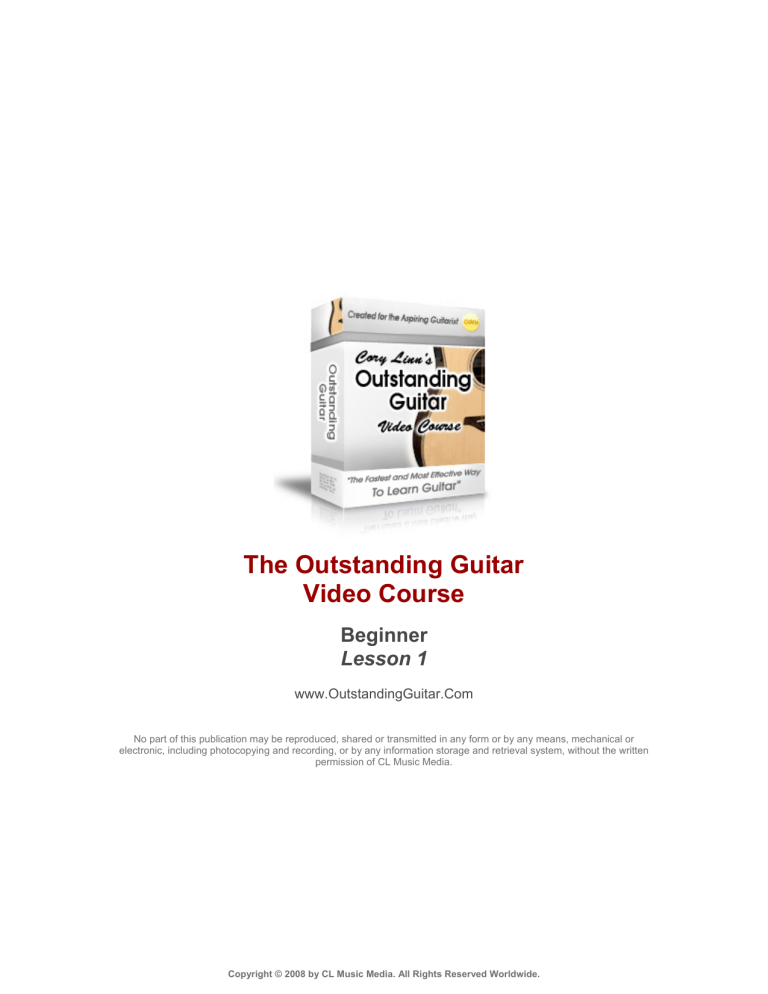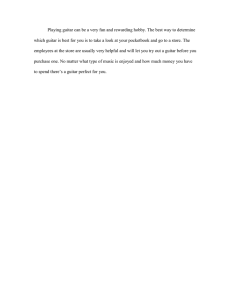
The Outstanding Guitar
Video Course
Beginner
Lesson 1
www.OutstandingGuitar.Com
No part of this publication may be reproduced, shared or transmitted in any form or by any means, mechanical or
electronic, including photocopying and recording, or by any information storage and retrieval system, without the written
permission of CL Music Media.
Copyright © 2008 by CL Music Media. All Rights Reserved Worldwide.
Introduction
Hello Aspiring Guitarist!
I’d like to thank you for your interest in The Outstanding Guitar Video Course. You have
just made an incredible decision by ordering & downloading what I believe to be the
Fastest & Most Effective Way To Learn Guitar.
I am confident that this will be the beginning of a fun & exciting venture for you as you
are taking your first steps towards learning to play the guitar.
Now before we get started, I would like to point out a few details regarding the course
itself. All lessons in the Outstanding Guitar Course are available in a zip file and can be
downloaded individually from within our member’s area.
Each lesson will include a standard pdf ebook, along with all Quicktime videos & MP3
audio files for that particular lesson. Once you have downloaded each lesson, we highly
recommend that you extract all files contained within each zip file. You will also want to
be sure that you have the latest versions of Quicktime & Adobe Reader installed on your
computer, in order to view the videos & ebook material.
In order to get the most out of the course, I want to encourage you to spend 15-20
minutes each day working with the material in these lessons. I would also suggest
finding a quiet area in your home to practice during this time. This will make it easier to
stay focused and retain the information I’m giving you.
Above all, I always encourage my students to take their time, relax and enjoy the
process. While you are more than welcome to work through the lessons as fast as you
would like; keep in mind that you have plenty of time to become an Outstanding
Guitarist.
Finally, please feel free to contact me with any questions. I’m more than happy to be of
assistance and would love to help bring out the best in your guitar playing. Thanks again
& enjoy the lessons.
God Bless,
Cory Linn
CL Music Media, President
www.OutstandingGuitar.Com
Copyright © 2008 by CL Music Media. All Rights Reserved Worldwide.
In order to make the most out of your learning experience, it’s incredibly important that
you become familiar with your guitar. So before we get into the actual playing, I want to
kick things off by covering the different parts of the guitar, as well as a few other basic
essentials that will benefit you as we are getting things underway.
It can be argued that the acoustic guitar is the most popular amongst guitarists. Acoustic
guitars come equipped with either steel strings or nylon strings. Steel string acoustics
are definitely the most common and are great for playing rock n’ roll & blues. Nylon
string acoustics, as seen below, are very popular for playing classical and folk music.
Copyright © 2008 by CL Music Media. All Rights Reserved Worldwide.
The electric guitar will typically have a few more features added to it, as in comparison to
the acoustic. For example, with an electric guitar you will usually have the pick-ups,
volume & tone knobs, and with certain models, a whammy bar.
The electric guitar shown in the picture below is pretty much stripped down to the basic
necessities. Check out the diagram to become familiar with the different parts…
Copyright © 2008 by CL Music Media. All Rights Reserved Worldwide.
Now one of the most important areas of the guitar you want to become familiar with is
the fretboard. This is where the majority of your playing is going to be done. So let’s take
just a moment to cover some of the key areas of the fretboard...
Your guitar, whether acoustic or electric, has six strings. These strings are numbered
from bottom to top, as seen in the image below.
String 1 is the thinnest string on the guitar, while string 6 is the thickest.
The frets bars run across the entire finger board of the guitar. While the above diagram
only shows frets 1-5, keep in mind that the majority of acoustic and electric guitars will
usually have approximately 22-24 frets.
Now you want to become familiar with the frets on your guitar as fast as possible. You
can save yourself a good amount of time by memorizing the frets on your guitar.
One approach to doing this is by studying the markers or dots that are placed on both
the fretboard and at the top of the guitar neck.
Another common way of naming guitar strings is by letter. For example…
So I encourage you to spend a few minutes becoming familiar with this material. Allow it
to sink in. The last thing you want to begin doing is troubleshooting and trying to figure
out what fret to go to once we begin playing.
Copyright © 2008 by CL Music Media. All Rights Reserved Worldwide.
Knowing how to properly hold your guitar is very important when starting out. The reason
being is that you want to be as comfortable as possible so that you can get the absolute
most out of your playing.
When you are playing the guitar in a
sitting position, be sure that you are
avoiding slouching over. This can add
unnecessary stress on your back and
ultimately hinder your playing.
I suggest using a stool or a nice chair that
does not have arms attached to it.
The most important thing to remember is
that you are comfortable. This will help
you to stay focused while practicing.
While I highly suggest that beginners practice
in a sitting position, you may decide that you
are more comfortable standing.
If you prefer to stand up while playing, you
will need a guitar strap that holds your guitar
in place.
You can adjust your strap to a comfortable
level so that you are able to fret notes &
chords with as little stress on your hands &
shoulders as possible.
It is always a good idea to adjust your strap
so that the guitar is positioned just below your
solar plexus area.
Regardless of whether you choose to sit or stand while practicing, try to keep in mind
that the one thing you definitely should focus on is being comfortable. We want to
completely eliminate as many distractions as possible.
Copyright © 2008 by CL Music Media. All Rights Reserved Worldwide.
Now let’s take a moment to talk about your hands. Your playing hand is the hand that
you will be using to fret notes and chords on the guitar.
So if you are playing the guitar right-handed, your
playing hand will be your left hand.
In the same way, if you are playing the guitar lefthanded, your playing hand will be your right hand.
Looking at your playing hand, we have the thumb,
followed by fingers 1, 2, 3 & 4.
While this may seem elementary, please keep in
mind that it is very important to train yourself to
use certain fingers for particular notes & chords on
the guitar.
As we begin playing in just a bit, you will see that
using the same fingers for certain exercises will
help you to quickly develop coordination and
muscle memory.
Now your strumming hand is the hand you will be using to strum & pick with. This can
also be referred to as your picking or rhythm hand. Obviously, this is the hand that you
will use to hold the guitar pick.
Holding the guitar pick correctly is incredibly important. Bad technique in this area can
have a negative effect on your overall sound on the guitar.
You will notice that the guitar pick is diamond
shaped. What you want to do is place the pick
between your thumb and finger 1. Be sure that
the pointed side of the pick is facing outwards, as
shown in the diagram.
Holding the guitar pick too tightly will cause a
nasty, clanking sound. On the other hand, holding
the pick too softly may cause you to continually
drop it. And that can get frustrating after a while.
So I want to suggest that you spend a few minutes here and there, placing the pick in
your strumming hand correctly, then removing it. Repeat this simple exercise several
times and with a little practice, you will become comfortable holding the guitar pick.
So now that we have covered some of the important basics of getting started, let’s go
tune up…
Copyright © 2008 by CL Music Media. All Rights Reserved Worldwide.
Learning how to properly tune your guitar is by far one of the most important things that
you can learn when starting out. The reason being is that if your guitar is out of whack,
then your playing simply will not sound right - regardless of how often you may practice.
In my opinion, the fastest and easiest way to tune your guitar is by using an electronic
tuner. An electronic tuner will tell you whether any particular string needs to be
sharpened or flattened.
It is by far the most common way of tuning a guitar. You can pick up an electronic tuner
from your local guitar shop or simply order one online. In the meantime, I will show you
how to tune your guitar by ear…
So we will begin by tuning string 1. Your goal is to get all six strings on your guitar in
tune with mine as heard in the audio clips. Here are the steps to take…
•
Start by carefully listening to the audio clip for string 1.
•
Begin picking string 1 on your guitar every 4-5 seconds.
•
You can begin tuning string 1 by slowly turning the appropriate tuning key that
matches your first string.
•
Turn the tuning key until the pitch of your string matches mine as heard in the
audio clip.
•
If you have trouble finding the matching pitch, try slowly turning the tuning key in
the opposite direction.
•
When string 1 is in tune, simply repeat these exact steps for strings 2-6.
String 1
String 2
String 3
String 4
String 5
Copyright © 2008 by CL Music Media. All Rights Reserved Worldwide.
String 6

